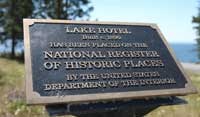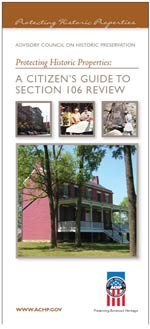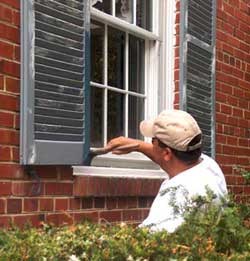
NPS/ Jody Lyle
There are many strategies for protecting places of significance and the best option for any given situation will depend greatly on the specific circumstances. For example, if you want to protect a battlefield, the National Park Service has a program specific to battlefield preservation.
Threats
The nature of the threat against a historic place will greatly influence which tools and programs will be of most value. Common threats include:
- encroaching development
- neglect and lack of maintenance
- natural hazards like floods and storms
- lack of understanding of the significance of the place
Fund a Project
Almost 20 grant programs support the survey, inventory, preservation, and documentation of historic resources as well as NAGPRA activities.

NPS/ HABS collection
Recognition and Documentation
The first step in providing protection is to investigate what you have and let other people know about it. Who you tell and how you inform should be strategic. Particularly for unsecured sites, it may be prudent to limit the message that there is a valuable resource to trusted partners and officials.
If a threat is imminent, documenting what is there before it is destroyed may be the only viable option. The Heritage Documentation Programs (HABS, HAER, and HALS) provides guidance about producing measured drawings, archival-quality photographs, and useful descriptive data.
The National Register of Historic Places and National Historic Landmarks Program provide both a mechanism for documentation and a certain level of promotion. Listing in the Register also provides a measure of protection from federally funded projects that could impact a significant place.
General promotion of a historic place can also help ensure long-term protection. If you can help your community care about its historic places, then there will be more people to stand with you against threats.
Combatting Encroaching Development
The most powerful tools available when a threat is related to new development are the strategic use of local land-use and zoning laws and plans. In every state, there are communities who are leaders in this area. Contact your State Historic Preservation Office (SHPO) to find out who the leaders are in your state that you can learn from. Technical assistance and funding to local communities is available through the Certified Local Government program.
In almost every case, the best outcomes for historic places occur when preservation has been a major part of community planning efforts. The Historic Preservation Planning Program provides guidance and assistance to help communities make sense of the planning process and ensure that it is useful and effective.
If you are the owner of the place you wish to protect, a historic preservation easement can provide significant protection from future development. An easement is a voluntary legal agreement, usually executed as a deed, that permanently protects the specified place. An easement donation may also provide tax benefits.

For development that includes an element of federal funding, licensing, or permitting, the federal agency involved is required to take into account the effects of their actions on historic properties and consult with stakeholders. This consultation process is generally referred to as Section 106. It is the responsibility of every federal agency to follow this process, but the Advisory Council on Historic Preservation provides guidance and oversight. Learn more about getting involved in this process with A Citizen's Guide to Section 106 Review.
For particularly significant places, it may be advantageous to designate the site as a local, state, or national park. The process for designating local and state parks will vary depending on your location. New units are generally added to the National Park System by an act of Congress. Sites on land that is federally managed can be proclaimed a national monument by the President and added to the National Park System in that way. It is worth noting, that designation as a park does not often directly relieve the threat of neglect and deferred maintenance. Government budgets at every level are often stretched thin and many agencies may require a significant monetary contribution to accompany a park designation in order to provide adequate stewardship of the site.

NPS/ Technical Preservation Services
Addressing Neglect
Neglected properties are found in every community. Unfortunately, there is relatively little that can be done to save a neglected property without the support and involvement of the owner. For that reason, one of the best methods of combatting neglect is the through the transfer of the property to an individual or organization with the resources to maintain it.
For federally owned properties that can no longer be maintained by the government, there are programs that transfer ownership with the specified goal of also preserving them. Historic federal buildings are most often transferred via the Historic Surplus Property program, which makes these buildings available at no cost to state, county, and local governments. Historic lighthouses are available to nonprofit, educational, and community development organizations and to state and local governments. Federal Lands to Parks is a third property transfer program that aims to ensure public access and appropriate stewardship.
If property transfer is not a possibility, providing information and educational opportunities about the maintenance of historic properties or ways to mothball a historic building may be the best option.
Preparing for Natural Hazards
Planning for potential disasters is an important aspect of community planning and protecting historic places. Although many communities have excellent hazard mitigation plans in terms of public safety and critical infrastructure, far fewer have considered historic resources in the development of their community plans. To help communities integrate historic properties into the planning process, the Federal Emergency Management Agency (FEMA) publishes a guide describing how to organize resources, assess risk, develop a mitigation plan, and implement the plan.

Mississippi Department of Archives and History
Last updated: November 1, 2023
